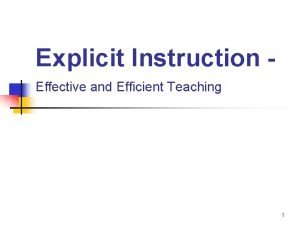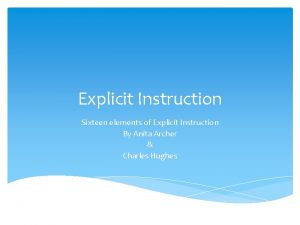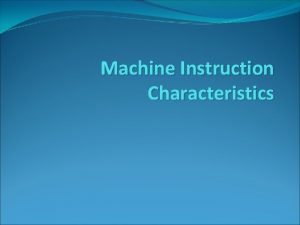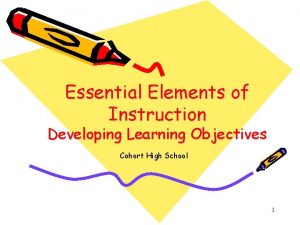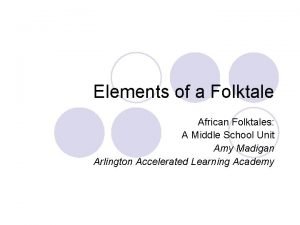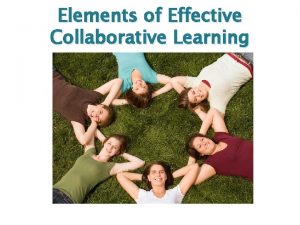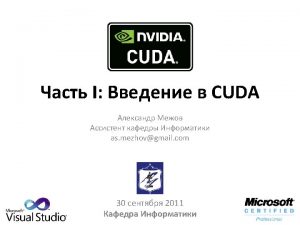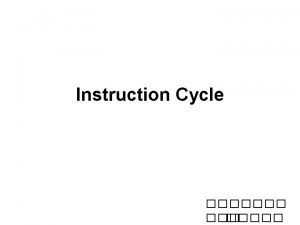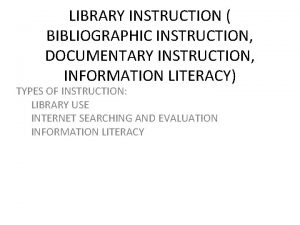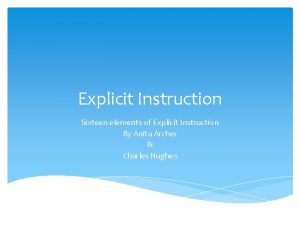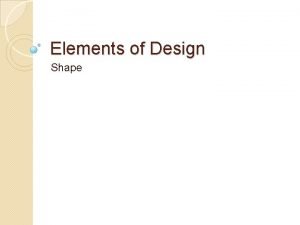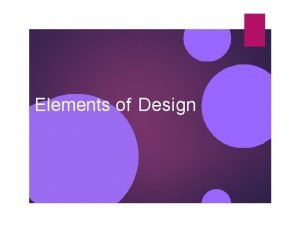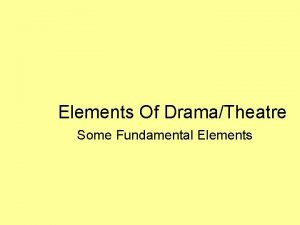3 Effective Instruction Overview Elements of effective instruction















- Slides: 15

3 Effective Instruction Overview Elements of effective instruction SECTION 1 Diversity of Students and Learning Styles SECTION 2 Active Learning SECTION 3 Facilitating Skill Development

By the end of this chapter, you are able to: • Concerned with student’s academic and non-academic problems; Provide opportunities for open -communication to all students and willingly assist students in respond to the diversity of their learning performance, prior knowledge, cultural background and interests. • Identify strategies teaching approaches to support the achievement of learning outcomes and to promote inclusive and positive student participation and engagement.

Elements of effective instruction: Make class sessions effective To keep students from being plunged into cognitive overload by a nonstop flow of information…. • Make your learning objectives and main points clear. • Use active learning. • Minimize distractions. • Periodically monitor your students' understanding of what you have just presented.

Elements of effective instruction: Make Pre-Class Assignments Effective • Trim assignments down to essential material. • Include online quizzes with reading assignments. • Have students generate and submit questions about readings. • Have students draw concept maps for assigned readings. • Consider giving in-class quizzes on readings, and then consider not giving them. • Don't be a slave to your session plans Motivating students to do pre-class work by implement Just-in-Time Teaching and Peer Instruction

Elements of effective instruction: Keep improving your teaching n io t c ru nst se r u s co an si t i d st s in ru n ctio it ons hi d i n t a ua of t e l se s r a r v u s ? u e ure arn o co ou c m e t s r e i dte at fea you l of th ning? of th ing y i M h g res lear ture elp n ce i W h n u p. a r l g _ a t 1 he fea ou fic fe ___ rnin ? rm y e o t _ f r i g a g r a c a ] h erin spe n ur le erin r pe o W d k. a c g yo hind you 2 hin a e b are s [nam t feed derin g nor prove e ? 3. I wan __hin elpin to im urse u hav h o you rn ___ ither u do the c do yo ? lea __ne can yo er of ents ction u ___ hat aind comm instr m 4. W he re other se or r in t hat e cou 5. W ut th abo You can always teach better. Here are several ways to do it: • Post-class reflection • End-of-course student ratings of teaching • Peer review of teaching • Midterm evaluations • Classroom assessment techniques • Expert consulting • Post-course reflection • Self-education

Section 1 Diversity of Students and Learning Styles

How diversity affects the classroom • Instructors’ assumptions about what a typical student should know, the resources they have and their prior knowledge are extremely important. • Students may perceive that they do not “belong” in the classroom setting — a feeling that can lead to decreased participation, feelings of inadequacy, and other distractions. • Teachers may make flawed assumptions of students’ capabilities or assume a uniform standard of student performance.

Level of Intellectual Development (Perry 1981) Hel pin the g st dev ude elo nts pm ent move al s up cale Commitment Relativism Multiplicity Duality Students enjoys demonstrating his/her own ideas and creative thoughts. Students begin to weight evidence and method of inquiry. They become active constructors of knowledge. Students appreciate that the dualistic construct may not be absolute and may experience dissonance due to varying opinions and views. Students are passive acceptors of objective clear cut knowledge that is committed to memory

Diversity of Students and Learning Styles (cont. ) Approaches to learning, levels of intellectual development, and learning styles have several features in common (Felder & Brent, 2005). They are all context dependent patterns of behavior rather than invariant human attributes and are based on extensive observation of students rather than brain physiology. Our goal should be to teach in an inclusive manner that helps as many students as possible to succeed.

Responding to Student Diversity • Treat students as individuals whose identifies are complex and unique. • Encourage full participation while being aware of differences which may influences’ response. • Vary your teaching methods to take advantage of different learning styles and to expand the repertoire of strategies tried by each student. • Promote a respectful classroom climate with egalitarian norms and acceptance of differences. • Be aware of possible student anxiety about their performance in a competitive environment such as Carnegie Mellon's but try not to "overprotect. "

Avoiding Common Problems • Provide some linguistic redundancy • Use diverse examples rather than ones which assume a particular background or experience. • Don't assume that students who don't talk don't know the material. • Watch the type of humor that occurs in your classes to be sure it denigrates no one.

Learning styles • Approaches to learning, levels of intellectual development, and learning styles have several features in common (Felder & Brent, 2005). They are all context dependent patterns of behavior rather than invariant human attributes and are based on extensive observation of students rather than brain physiology.

The Experiential Learning (David Kolb’s model) 1. Concrete Experience - (a new experience of situation is encountered, or a reinterpretation of existing experience). 2. Reflective Observation (of the new experience. Of particular importance are any inconsistencies between experience and understanding). 3. Abstract Conceptualization (Reflection gives rise to a new idea, or a modification of an existing abstract concept). 4. Active Experimentation (the learner applies them to the world around them to see what results).

VARK Modalities(Fleming and Mills, 1992) Field trip Read book Pod cast Fixing machine • Visual Learner learn by sight • Auditory Learner learn by hearing • Read/Write Learn by read and write • Tactile Learner(Kinesthetic) learn by touch

Assumption of Learning styles • “Learners have preferences about how to learn that are independent of both ability and content and have meaningful implications for their learning. ” • “Learning can be improved by matching instruction to students' learning styles. ” Research does not support designing instruction to match learning styles.
 Carbon family
Carbon family Chapter 17 overview elements and their properties
Chapter 17 overview elements and their properties Differentiated instruction vs individualized instruction
Differentiated instruction vs individualized instruction Direct instruction vs indirect instruction
Direct instruction vs indirect instruction Examples of explicit instruction
Examples of explicit instruction 16 elements of explicit instruction
16 elements of explicit instruction Characteristics of good instruction format
Characteristics of good instruction format Essential elements of instruction
Essential elements of instruction How many elements does an effective compliance program have
How many elements does an effective compliance program have Elements of effective classroom management
Elements of effective classroom management What are the literary elements of a drama
What are the literary elements of a drama Oracle landed cost management
Oracle landed cost management Molecular element
Molecular element Http //elements.wlonk.com/elements table.htm
Http //elements.wlonk.com/elements table.htm What are the 3 elements of folktales?
What are the 3 elements of folktales? Elements of folk tale
Elements of folk tale




